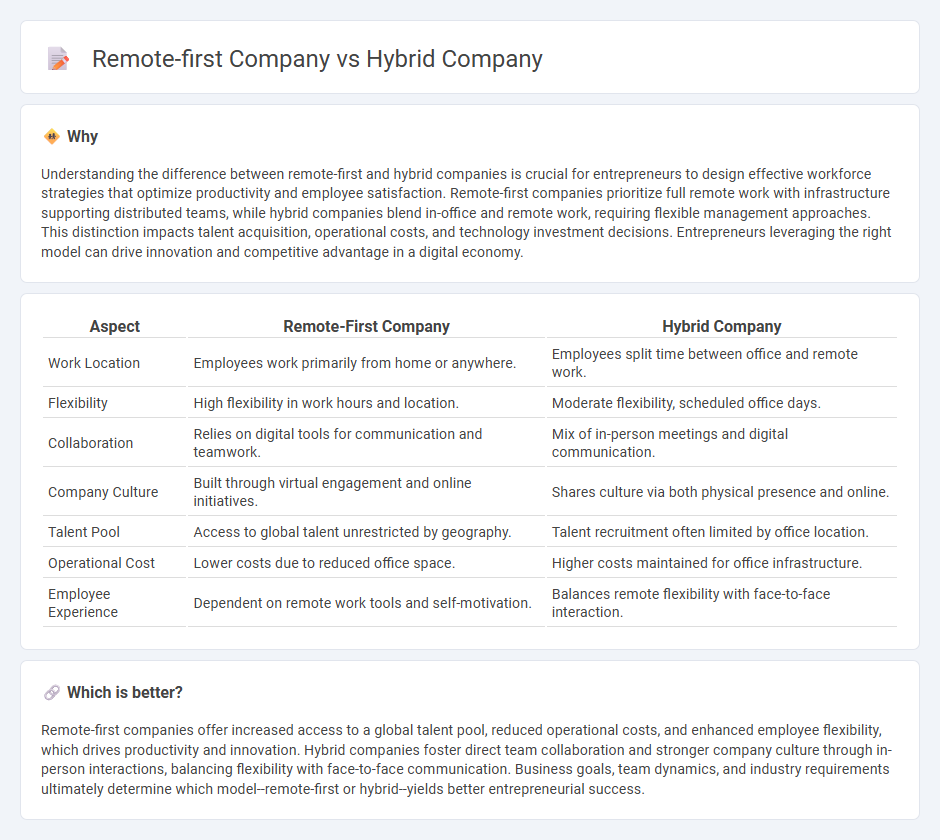
Remote-first companies prioritize full-time remote work, fostering a culture centered on virtual collaboration and flexible work environments, which often leads to increased employee autonomy and access to a diverse talent pool. Hybrid companies combine in-office and remote work, aiming to balance face-to-face interaction with the benefits of remote flexibility, thus supporting varied employee preferences and enhancing team cohesion. Explore the key differences and strategic benefits of remote-first versus hybrid models to optimize your entrepreneurial approach.
Why it is important
Understanding the difference between remote-first and hybrid companies is crucial for entrepreneurs to design effective workforce strategies that optimize productivity and employee satisfaction. Remote-first companies prioritize full remote work with infrastructure supporting distributed teams, while hybrid companies blend in-office and remote work, requiring flexible management approaches. This distinction impacts talent acquisition, operational costs, and technology investment decisions. Entrepreneurs leveraging the right model can drive innovation and competitive advantage in a digital economy.
Comparison Table
| Aspect | Remote-First Company | Hybrid Company |
|---|---|---|
| Work Location | Employees work primarily from home or anywhere. | Employees split time between office and remote work. |
| Flexibility | High flexibility in work hours and location. | Moderate flexibility, scheduled office days. |
| Collaboration | Relies on digital tools for communication and teamwork. | Mix of in-person meetings and digital communication. |
| Company Culture | Built through virtual engagement and online initiatives. | Shares culture via both physical presence and online. |
| Talent Pool | Access to global talent unrestricted by geography. | Talent recruitment often limited by office location. |
| Operational Cost | Lower costs due to reduced office space. | Higher costs maintained for office infrastructure. |
| Employee Experience | Dependent on remote work tools and self-motivation. | Balances remote flexibility with face-to-face interaction. |
Which is better?
Remote-first companies offer increased access to a global talent pool, reduced operational costs, and enhanced employee flexibility, which drives productivity and innovation. Hybrid companies foster direct team collaboration and stronger company culture through in-person interactions, balancing flexibility with face-to-face communication. Business goals, team dynamics, and industry requirements ultimately determine which model--remote-first or hybrid--yields better entrepreneurial success.
Connection
Remote-first companies and hybrid companies both embrace flexible work models to enhance employee productivity and satisfaction. Remote-first companies prioritize fully remote operations, leveraging digital tools to maintain seamless communication across distributed teams, while hybrid companies combine in-office and remote work to balance collaboration and individual work preferences. Both models rely on cloud technologies and robust project management systems to support agility and innovation in entrepreneurial ventures.
Key Terms
Work Model
Hybrid company work models balance on-site and remote work, offering employees flexibility while maintaining some in-person collaboration. Remote-first companies prioritize virtual work environments, enabling teams to operate fully online with minimal physical office presence. Explore how these distinct work models impact productivity and employee satisfaction to determine the best fit for your organization.
Flexibility
Hybrid companies offer employees a blend of in-office and remote work, providing flexibility to balance collaboration and personal preferences. Remote-first companies prioritize a fully distributed workforce, optimizing tools and processes exclusively for remote productivity and communication. Explore more to understand which flexibility model best suits your organizational needs and employee satisfaction.
Collaboration Tools
Hybrid companies rely on collaboration tools like Microsoft Teams and Slack to bridge the gap between in-office and remote employees, optimizing real-time communication and project management. Remote-first companies prioritize cloud-based platforms such as Zoom, Asana, and Miro to ensure seamless collaboration regardless of location, emphasizing asynchronous workflows and flexibility. Explore more about how different collaboration tools shape productivity and team dynamics in hybrid versus remote-first environments.
Source and External Links
What Are Hybrid Companies? [An Overview and 5 Examples] - A hybrid company is one that embraces a hybrid work model, allowing employees to work both remotely and in person at the office.
Hybrid - An education and technology specialist media and creative agency operating globally, focusing on leveraging data and insights to connect audiences with higher education institutions.
Hybrid & Company Women's Clothing On Sale Up To 90% Off Retail - A women's clothing brand offering a range of apparel such as skirts, cardigans, and pants at discounted prices.
 dowidth.com
dowidth.com